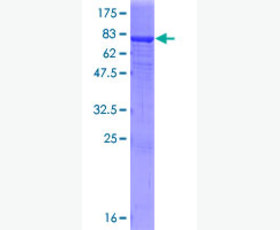Recombinant Human Dihydropteridine Reductase/QDPR
| Product name: | Recombinant Human Dihydropteridine Reductase/QDPR |
| Source: | Human Cells |
| Purity: | Greater than 95% as determined by reducing SDS-PAGE. |
| Buffer Formulation: | Lyophilized from a 0.2 μm filtered solution of 20mM TrisHCl,pH8.0. |
| Applications: | Applications:SDS-PAGE; WB; ELISA; IP. |
| Storage: | Avoid repeated freeze/thaw cycles. Store at 2-8 oC for one month. Aliquot and store at -80 oC for 12 months. |
| UOM: | 100ug/50ug/200ug/1mg/1g |
| Source | Human Cells |
| Description | Recombinant Human Dihydropteridine Reductase is produced by our Mammalian expression system and the target gene encoding Ala2-Phe244 is expressed with a 6His tag at the C-terminus. |
| Names | Dihydropteridine Reductase, HDHPR, Quinoid Dihydropteridine Reductase, QDPR, DHPR |
| Accession # | P09417 |
| Formulation | Lyophilized from a 0.2 μm filtered solution of 20mM TrisHCl,pH8.0. |
| Shipping |
The product is shipped at ambient temperature. |
| Reconstitution |
Always centrifuge tubes before opening. Do not mix by vortex or pipetting. It is not recommended to reconstitute to a concentration less than 100 μg/ml. Dissolve the lyophilized protein in ddH2O. Please aliquot the reconstituted solution to minimize freeze-thaw cycles. |
| Storage |
Lyophilized protein should be stored at < -20°C, though stable at room temperature for 3 weeks. Reconstituted protein solution can be stored at 4-7°C for 2-7 days. Aliquots of reconstituted samples are stable at < -20°C for 3 months. |
| Purity |
Greater than 95% as determined by reducing SDS-PAGE. |
| Endotoxin | Less than 0.1 ng/µg (1 IEU/µg) as determined by LAL test. |
| Amino Acid Sequence |
AAAAAAGEARRVLVYGGRGALGSRCVQAFRARNWWVASVDVVENEEASASIIVKMTDSFTEQADQ VTAEVGKLLGEEKVDAILCVAGGWAGGNAKSKSLFKNCDLMWKQSIWTSTISSHLATKHLKEGGL LTLAGAKAALDGTPGMIGYGMAKGAVHQLCQSLAGKNSGMPPGAAAIAVLPVTLDTPMNRKSMPE ADFSSWTPLEFLVETFHDWITGKNRPSSGSLIQVVTTEGRTELTPAYFVDHHHHHH
|
| Background | Dihydropteridine reductase, also known as HDHPR and Quinoid dihydropteridine reductase, QDPR and DHPR, belongs to the short-chain dehydrogenases/reductases (SDR) family. QDPR exists as a homodimer. QDPR is part of the pathway that recycles a substance called tetrahydrobiopterin, also known as BH4 and tryptophan hydroxylases. The regeneration of this substance is critical for the proper processing of several other amino acids in the body. Tetrahydrobiopterin also helps produce certain chemicals in the brain called neurotransmitters, which transmit signals between nerve cells. Defects in QDPR are the cause of BH4-deficient hyperphenylalaninemia type C (HPABH4C) which is a rare autosomal recessive disorder and is lethal. |














